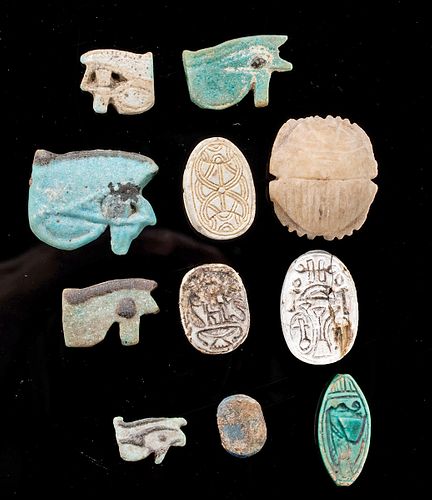Egyptian Faience Wedjat Eye Amulets + Scarabs (11 pcs)
Lot 2e
About Seller
Artemis Fine Arts
686 S Taylor Ave, Ste 106
Louisville, CO 80027
United States
Selling antiquities, ancient and ethnographic art online since 1993, Artemis Gallery specializes in Classical Antiquities (Egyptian, Greek, Roman, Near Eastern), Asian, Pre-Columbian, African / Tribal / Oceanographic art. Our extensive inventory includes pottery, stone, metal, wood, glass and textil...Read more
Categories
Estimate:
$2,500 - $3,500
Absentee vs Live bid
Two ways to bid:
- Leave a max absentee bid and the platform will bid on your behalf up to your maximum bid during the live auction.
- Bid live during the auction and your bids will be submitted real-time to the auctioneer.
Bid Increments
| Price | Bid Increment |
|---|---|
| $0 | $25 |
| $300 | $50 |
| $1,000 | $100 |
| $2,000 | $250 |
| $5,000 | $500 |
| $10,000 | $1,000 |
| $20,000 | $2,500 |
| $50,000 | $5,000 |
| $100,000 | $10,000 |
| $200,000 | $20,000 |
About Auction
By Artemis Fine Arts
Feb 13, 2020
Set Reminder
2020-02-13 10:00:00
2020-02-13 10:00:00
America/New_York
Bidsquare
Bidsquare : Exceptional Antiquities, Asian, Ethnographic
https://www.bidsquare.com/auctions/artemis-gallery/exceptional-antiquities-asian-ethnographic-4848
An important one-day auction featuring museum-worthy examples of Egyptian, Greek, Roman, Etruscan, Near Eastern, Far East / Asian, Pre-Columbian, African / Tribal, Oceanic, Native American, Spanish Colonial, Russian, Fossils, Ancient Jewelry, Fine Art, so much more! Artemis Fine Arts info@artemisfinearts.com
An important one-day auction featuring museum-worthy examples of Egyptian, Greek, Roman, Etruscan, Near Eastern, Far East / Asian, Pre-Columbian, African / Tribal, Oceanic, Native American, Spanish Colonial, Russian, Fossils, Ancient Jewelry, Fine Art, so much more! Artemis Fine Arts info@artemisfinearts.com
- Lot Description
Ancient Egypt, Middle Kingdom to New Kingdom Period, 11th to 20th Dynasty, ca. 2130 to 1077 BCE. A lovely gathering of eleven attractive amulets formed from faience, stone, or wood, with ten bearing perforated suspension holes, and a petite heart scarab with an unperforated body. Five glazed faience amulets depict a powerful ancient symbol of protection known as the wadjet (or wedjat or Eye of Horus) with large eyes, sweeping lashes, and delineated pupils. A stone heart scarab exhibits typical insectile features as well as a horizontally striated base. One Middle Kingdom stone scarab features curvilinear motifs suggestive of Herakleopolis. The base of a wooden, white-painted scarab features hieroglyphs for 'beauty' and 'life' on the base. A green-glazed cowroid features an abstract image of the goddess Tawaret. A petite lapis lazuli scarab has an uncarved base, and a stone scarab shows a pharaoh and the hieroglyph for 'gold.' Size of largest (heart scarab): 0.9" L x 0.8" W (2.3 cm x 2 cm)
The scarab, beloved in ancient Egypt as a sacred beetle, was an emblem of Khepera, the creator. Given that the word "kepher" can be translated as "creation, existence, being, or becoming," the god Khepera was by extension regarded as the creator of all. Symbolic of resurrection and fertility, carved scarabs served two primary roles: as personal seals to identify the property of the individual whose name was placed upon them, and as amulet possessing spiritual and protective powers. In either case, the scarab was thought to possess immense power. Serving as the owner's signature, the scarab brought about wealth and prosperity during the individual's lifetime. During the afterlife, the scarab was thought to bring about rebirth and eternal life.
According to the AMA Journal of Ethics, "The well-known symbol Rx may even be derived from Egyptian hieroglyphics. According to the legend, Horus, the god of sky and of light and keeper of secret wisdom, sustained a terrible eye injury while seeking to avenge the murder of his father. Later, the eye was magically healed. The eye of Horus thus became a symbol of health, now recognized as Rx, and its placement by physicians on written prescriptions represents an appeal for the success of the recommended remedy."
Provenance: private J.H. collection, Beaverton, Oregon, USA, acquired between the late 1980s and 2001; ex-Castle Coins collection, Portland, Oregon, USA; (heart scarab) ex-Tom Cederlind collection, Portland, Oregon, USA
All items legal to buy/sell under U.S. Statute covering cultural patrimony Code 2600, CHAPTER 14, and are guaranteed to be as described or your money back.
A Certificate of Authenticity will accompany all winning bids.
We ship worldwide and handle all shipping in-house for your convenience.
#152606Repairs to lapis lazuli and wood scarabs, with small chips to wood scarab, and light adhesive residue along break lines; the remaining items are intact and very good. All items have minor nicks, abrasions, and softening to finer details commensurate with age, with fading to original glaze pigment, and light encrustations. Light earthen deposits and great remaining details on bases.Condition
- Shipping Info
-
All shipping is handled in-house for your convenience. Your invoice from Artemis Gallery will include shipping calculation instructions. If in doubt, please inquire BEFORE bidding for estimated shipping costs for individual items.
-
- Buyer's Premium



 EUR
EUR CAD
CAD AUD
AUD GBP
GBP MXN
MXN HKD
HKD CNY
CNY MYR
MYR SEK
SEK SGD
SGD CHF
CHF THB
THB












